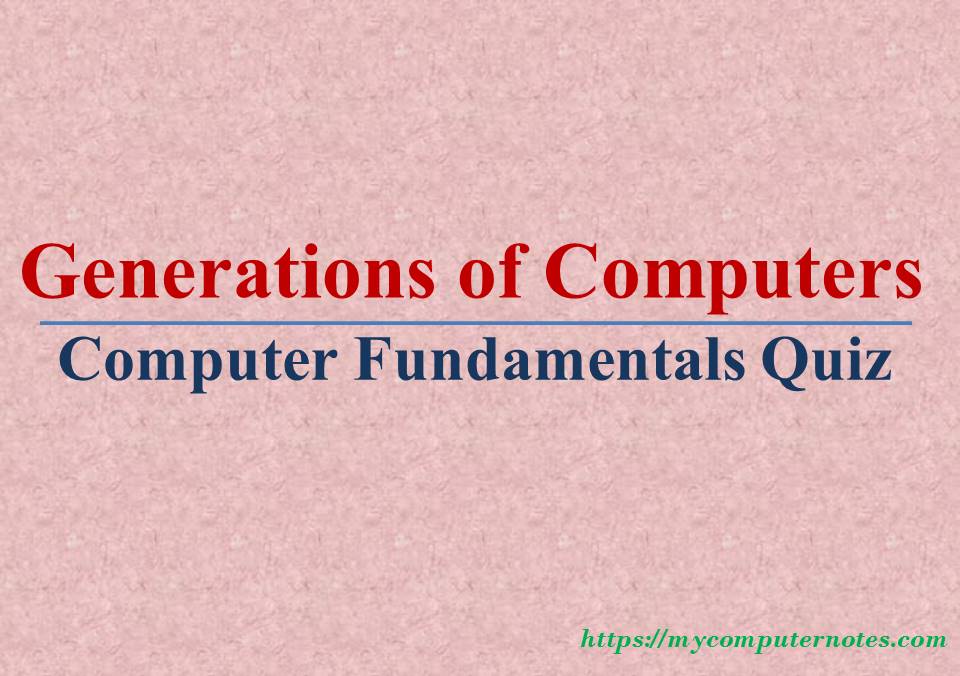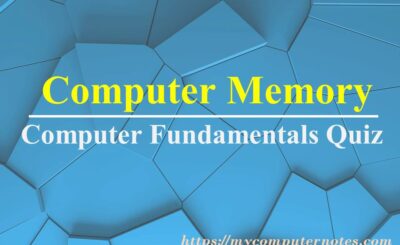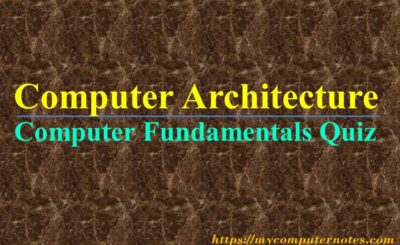| ← Prev | Next → |
 This MCQ section contains the Computer fundamentals quiz – Generations of computers. You can test your IQ on the generations of computers Each question is a multiple-choice type with a single answer. The section consists of 20 questions with multiple-choice options.
This MCQ section contains the Computer fundamentals quiz – Generations of computers. You can test your IQ on the generations of computers Each question is a multiple-choice type with a single answer. The section consists of 20 questions with multiple-choice options.
Each question is provided with the correct answer and an explanation for the correct answer. Click on the button named “Answer” just below the question to view the answer and the explanation. You can hide the answer and the explanation by re-clicking the “Answer” button.
Computer Fundamentals Quiz – Generations of Computers
|
1. Which of the following terms define the technological advancement in the field of computers through the ages?
Answer: Option C Explanation: The generations of computers define the significant advancement in computer technology and how the size of the computer reduced drastically throughout the span of the technology revolution. It is classified into 5 different generations.
|
|
2. What was the time period of the first generation of computers?
Answer: Option A Explanation: The time period of first-generation computers was between 1946-1959.
|
|
3. What was the time period of the second generation of computers?
Answer: Option B Explanation: The time period of second-generation computers was between 1959-1965.
|
|
4. What was the time period of the third generation of computers?
Answer: Option C Explanation: The time period of third-generation computers was between 1965-1971.
|
5. Vacuum tubes were introduced in ________ generations.
Answer: Option A Explanation: The computers of the first generation had used vacuum tubes as the major switching device. It was invented by Sir John Ambrose Fleming in 1904.
|
6. IBM 7090 was developed in _____________ generation of computer.
Answer: Option B Explanation: IBM 7090 is the upgraded version of the earlier IBM 709 vacuum tube version mainframe computer. IBM 7090 is the fully transistorized version developed in 1960.
|
7. The major talking point of fifth generation computers are___________.
Answer: Option B Explanation: Artificial intelligence is the major technological breakthrough in the fifth generation. Artificial intelligence or simply AI is the mimicry of human intelligence by the computer system. The computer programmed with artificial intelligence can think and react like the human brain.
|
|
8. In which generation of computer microprocessors was introduced?
Answer: Option D Explanation: The major development in the fourth generation is the invention of microprocessors. The first microprocessor chip Intel 4004 was developed in 1971.
|
9. UNIVAC stands for _________________________ .
Answer: Option A Explanation: UNIVAC stands for Universal Automatic Computer. UNIVAC was the first general-purpose electronic digital computer developed by J. Presper Eckert and John Mauchly
|
10. In which generation of computers, integrated circuits (ICs) did come into existence?
Answer: Option C Explanation: The integrated circuit (IC) was introduced during the third generation of computers.
|
|
11. When was the vacuum tube is invented?
Answer: Option C Explanation: The vacuum tube was invented in 1904 by Sir John Ambrose Fleming.
|
|
12. Which of the following IBM series was the most popular first-generation computer?
Answer: Option A Explanation: IBM 650 was developed in the mid-1950s.
|
13. Which of the following was the world’s first laptop in the modern form?
Answer: Option A Explanation: The Toshiba 1100 was considered to be the world’s first laptop in the modern form.
|
14. Operating system was developed from which generation?
Answer: Option C Explanation: The operating system was developed during the third generation of computers.
|
|
15. EDSAC stands for ____________________________. Electronic Delay Second Automatic Calculator Electronic Delay Storage Automatic Calculator Electrical Delay System Automatic Calculator Electronic Delay System Automatic Computer
Answer: Option B Explanation: EDSAC stands for Electronic Delay Storage Automatic Calculator. EDSAC was originally developed at the University of Cambridge Mathematical Laboratory, England in 1948.
|
|
16. ENIAC stands for ______________________________.
Answer: Option B Explanation: ENIAC stands for Electronic Numerical Integrator and Calculator. ENIAC was the first general-purpose programmable digital computer developed by John Mauchly and J. Presper Eckert during World War II.
|
17. Which of the following statements are not true for the first generation computers?
Answer: Option C Explanation: The first generation computers are large in size, about the size of the room. They consume more power and also generate enormous heat. Because they use vacuum tubes as switching devices. However, transistors are semiconductor devices used in the second generation of computers.
|
|
18. Which of the following statement is not correct for the second generation of computers?
Answer: Option B Explanation: Microprocessors were developed during the fourth generation.
|
|
19. Which of the following statements were not true about the fourth generation of computers?
Answer: Option D Explanation: Options A, B, and C are the major features of the fourth generation of computers.
|
|
20. Which of the following is the first programming language?
Answer: Option C Explanation: FORTRAN stands for Formula Translation. It is a general-purpose programming language specially made for numeric and scientific computation.
|
| ← Prev | Next → |






